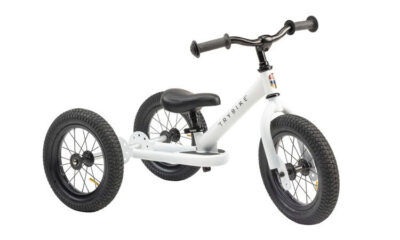Gadgets
Why are some cities worse for allergies than others?

Spring is underway in the Northern Hemisphere–and so is allergy season. While that means warmer temps and blooming flowers and trees, it also means that unpleasant sneezing and coughing from common seasonal allergens is arriving right along with those buds. While anywhere that there is plant growth is susceptible to various pollens and ragweed, some cities and regions in the United States seem notoriously bad for allergy sufferers.
“Everyone thinks their area is the worst because so many people suffer from allergies” Dr. Robert Zemble, the Division Chief of Allergy for the Lehigh Valley Health Network in Pennsylvania, tells Popular Science. .”
Which cities are the worst for allergies?
The Asthma and Allergy Foundation released its annual Allergy Capitals list in March. The report uses data from the 100 most-populated metropolitan areas in the country on tree, grass, and weed pollen scores throughout the year, usage of over-the-counter allergy medicine, as well as the availability of board-certified allergists/immunologists.
This year’s top 10 are:
| Wichita, Kansas |
| New Orleans, Louisiana |
| Oklahoma City, Oklahoma |
| Tulsa, Oklahoma |
| Memphis, Tennessee |
| Little Rock, Arkansas |
| Raleigh, North Carolina |
| Richmond, Virginia |
| Greenville, South Carolina |
| Greensboro, North Carolina |
“Allergy season is in full swing–and if your symptoms feel worse than usual, you’re not imagining it! Allergy symptoms are starting earlier, lasting longer, and affecting more people than ever before,” pharmacist Stacia Woodcock tells Popular Science. “New data from GoodRx shows that prescription fills for allergy medications are at their highest point for this time of year in six years. In fact, fills for nearly 75 of the most popular allergy medications are spiking—and still climbing.”
Why are some places worse than others?
There are several factors behind what makes a region particularly sneezy and vulnerable to certain allergens. One is the amount of frost-free days, which we are having less of, primarily due to climate change.
“If you have less days with frost, you’ll get more days with plant growth and pollen production,” says Zemble. “The top cities tend to cluster around the Southeast, mid-Atlantic, and Midwest. So it’s a distribution of plant growth and the amount of time that the plants have to grow.”
The amount of air pollution in a region can also affect anything related to the airways. While living next to a highway or in a more urban setting might mean less irritation from pollen and plant growth, pollution from motor vehicles can cause problems as well. The urban heat island effect–where paved surfaces in cities trap heat and raise the temperature–can also impact breathing.
“It might seem counter intuitive, that sometimes we need to plant more trees to have less symptoms of tree allergies,” says Zemble. “But sometimes that’s the case.”
For those living in more suburban or rural areas, the geographical features around them play a role. Zemble treats patients in Pennsylvania’s Lehigh Valley. Situated in the Appalachian Mountains, it also includes the state’s third largest metropolitan area.
“Basically, one of the explanations that we often give is that we are in this valley,” says Zemble. “The pollen sits here and it collects and affects us for a longer period of time, instead of passing through and moving on.”
[ Related: It’s stuffy nose season. Here’s how to cope. ]
How to choose the right allergy medicine
First and foremost, always speak with a healthcare professional or pharmacist before starting any medication. The best treatment will depend on symptoms, how often they occur, how severe they are, and personal factors like age.
Allergy treatments primarily fall into three main categories: antihistamines, nasal corticosteroids, and decongestants. They each work differently, many are available over-the-counter, but some may require a prescription.
For those with allergy symptoms that only show up occasionally–like during pollen season or after being around pets–Woodcock recommends oral antihistamines like loratadine (Claritin).
“These medications are effective for sneezing, runny nose, and itchy or watery eyes, and they typically begin working within a few hours,” says Woodcock. “If you need even faster relief, antihistamine nasal sprays like azelastine (Astelin) can start reducing symptoms in as little as 15 minutes.”
Those suffering from more persistent and daily symptoms can benefit from nasal corticosteroid sprays like fluticasone propionate (Flonase) or mometasone (Nasonex).
“They target nasal inflammation and congestion, but may take up to 2 weeks to reach full effectiveness,” says Woodcock. “For seasonal allergies, it’s a good idea to start a nasal steroid spray 2 weeks before your symptoms typically start. You can also combine a nasal steroid with an oral antihistamine for a couple of weeks to give the nasal spray time to reach its full effect but still manage your symptoms.”
While decongestants can help with the stuffy nose that comes from some allergy season, they won’t stop the allergy itself.
“Oral decongestants, such as pseudoephedrine (Sudafed), are kept behind the pharmacy counter. They’re also often added to oral antihistamines in a combination pill, such as loratadine / pseudoephedrine (Claritin-D). Decongestant nasal sprays like oxymetazoline (Afrin) work quickly to reduce nasal swelling and open airways,” says Woodcock. “But you shouldn’t use a decongestant nasal spray for more than 3 days in a row to avoid rebound congestion that can be difficult to treat.”
This story is part of Popular Science’s Ask Us Anything series, where we answer your most outlandish, mind-burning questions, from the ordinary to the off-the-wall.
Do you have a burning question that you’ve always wanted to ask? Look no further, as we are here to help! Our team at PopSci is dedicated to testing and reviewing hundreds of products to bring you the best gear and gadgets that money can buy. Whether you’re interested in aquatic life, paleontology, nanotechnology, or how science impacts our daily lives, we’ve got you covered.
Feel free to reach out to us with any inquiries you may have. Our news editor, Laura, is passionate about a wide range of topics and is always eager to explore new scientific discoveries. Ask away and let us satisfy your curiosity!
-

 Destination9 months ago
Destination9 months agoSingapore Airlines CEO set to join board of Air India, BA News, BA
-

 Breaking News10 months ago
Breaking News10 months agoCroatia to reintroduce compulsory military draft as regional tensions soar
-

 Gadgets4 months ago
Gadgets4 months agoSupernatural Season 16 Revival News, Cast, Plot and Release Date
-

 Tech News1 year ago
Tech News1 year agoBangladeshi police agents accused of selling citizens’ personal information on Telegram
-

 Productivity12 months ago
Productivity12 months agoHow Your Contact Center Can Become A Customer Engagement Center
-

 Gadgets1 month ago
Gadgets1 month agoFallout Season 2 Potential Release Date, Cast, Plot and News
-

 Breaking News10 months ago
Breaking News10 months agoBangladesh crisis: Refaat Ahmed sworn in as Bangladesh’s new chief justice
-

 Toys1 year ago
Toys1 year ago15 of the Best Trike & Tricycles Mums Recommend























